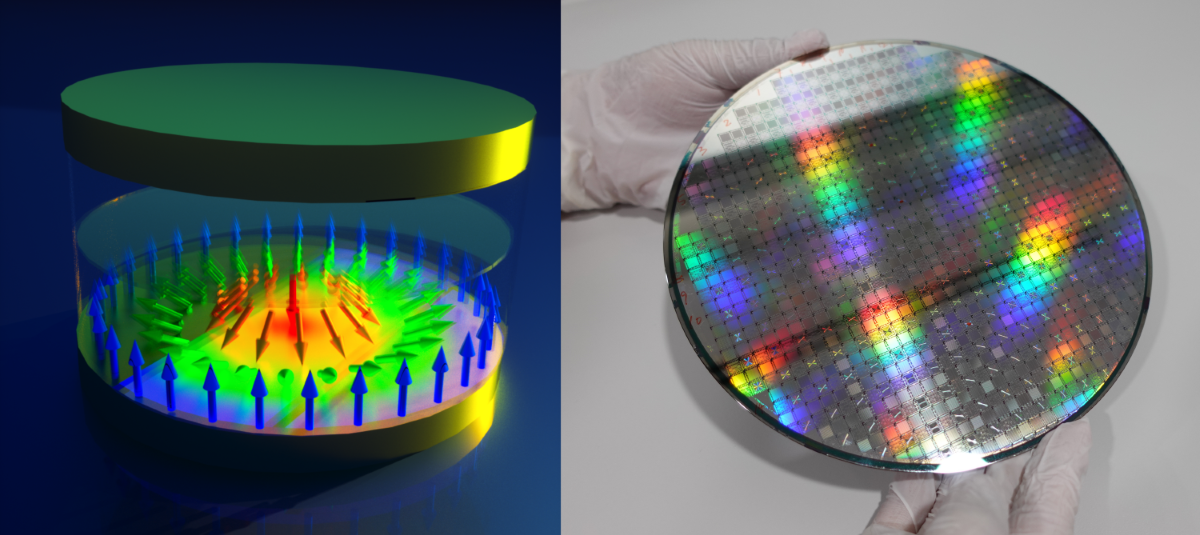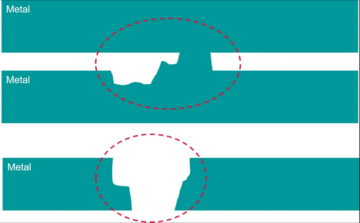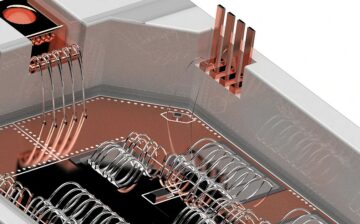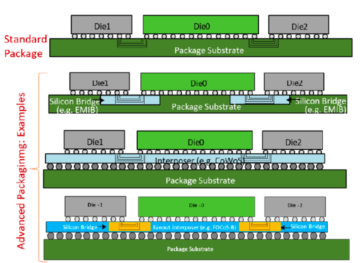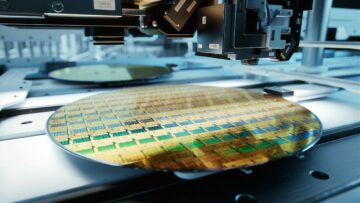Skyrmion switches
Researchers from the Agency for Science, Technology and Research (A*STAR) and National University of Singapore harnessed skyrmions to build a switch that has the potential to process data faster while using significantly less energy.
Skyrmions are magnetic whirls that form in very thin metal layers and can be efficiently moved between magnetic regions. Using a magnetic tunnel junction, the team performed electrical readout of a skyrmion and electrical switching between states, finding that switching between states used 1,000 times less power than commercial devices. They also found that more than two states can be achieved within a single device.
(Left) Artist rendition of the skyrmionic microelectronic device. (Right) 200 mm device wafer containing over 100,000 skyrmion microelectronic devices (Credit: A*STAR and NUS)
The skyrmion-based devices were fabricated on 200 mm silicon wafers using materials and methods already used in foundries. The team hopes that with further refinement of the electrical performance, the switch can be integrated into microprocessors using established approaches. [1]
Helical magnets
Researchers from Tohoku University and Toho University propose using helical magnets to create a magnetic memory device with reduced crosstalk between magnetic bits.
In helical magnets, the directions of the atomic magnetic moments are ordered in a spiral. The chirality, or right- and left-handedness, of the spiral could be used to store information. The magnetic fields induced by each atomic magnetic moment cancel each other out, so the helical magnets do not generate any macroscopic magnetic field. “The memory devices based on the handedness of the helimagnets, free from the crosstalk among bits, could pave a new pathway for improving the memory density,” said Hidetoshi Masuda, an assistant professor at Tohoku University’s Institute for Materials Research, in a release.
The chirality memory can be written and read out at room temperature. The team fabricated epitaxial thin films of a room-temperature helimagnet MnAu2 and demonstrated the switching of chirality by the electric current pulses under magnetic fields. They also fabricated a bilayer device composed of MnAu2 and platinum and demonstrated that the chirality memory can be read out as a resistance change, even without magnetic fields. [2]
Silicon-compatible magnetic whirls
Researchers from the University of Oxford, National University of Singapore, and Paul Scherrer Institut were able to create magnetic whirls in membranes that can be seamlessly integrated with silicon. Magnetic whirls in antiferromagnets have the potential to act as much faster information carriers, but could only be created on rigid crystal templates.
To enable them on silicon, Paolo Radaelli, professor at Oxford University, said in a statement that the team “fabricated ultra-thin crystalline membranes of hematite (the main component of rust and thus the most abundant antiferromagnet) that extended laterally over macroscopic dimensions. Such membranes are relatively new in the world of crystalline quantum materials, and combine advantageous characteristics of both bulk 3D ceramics and 2D materials, while also being easily transferrable.”
The hematite layer was grown on top of a crystal template that was coated with a sacrificial layer made from a cement component, which was then dissolved in water to separate the hematite from the crystal base. Finally, the free-standing hematite membrane was transferred onto silicon and several other desirable platforms.
“One of our most exciting discoveries was the extreme flexibility of our hematite membranes,” added Hariom Jani, a postdoctoral fellow at Oxford University, in a release. “Unlike their rigid, ceramic-like bulk counterparts that are prone to breaking, our flexible membranes can be twisted, bent, or curled into various shapes without fracturing. We exploited this newfound flexibility to design magnetic whirls in three dimensions, something that was previously not possible. In the future, the shape of these membranes could be tweaked to realize completely new whirls in 3D magnetic circuits.” [3]
References
[1] Chen, S., Lourembam, J., Ho, P. et al. All-electrical skyrmionic magnetic tunnel junction. Nature 627, 522–527 (2024). https://doi.org/10.1038/s41586-024-07131-7
[2] Masuda, H., Seki, T., Ohe, Ji. et al. Room temperature chirality switching and detection in a helimagnetic MnAu2 thin film. Nat Commun 15, 1999 (2024). https://doi.org/10.1038/s41467-024-46326-4
[3] Jani, H., Harrison, J., Hooda, S. et al. Spatially reconfigurable antiferromagnetic states in topologically rich free-standing nanomembranes. Nat. Mater. (2024). https://doi.org/10.1038/s41563-024-01806-2

Jesse Allen
Jesse Allen is the Knowledge Center administrator and a senior editor at Semiconductor Engineering.
- SEO Powered Content & PR Distribution. Get Amplified Today.
- PlatoData.Network Vertical Generative Ai. Empower Yourself. Access Here.
- PlatoAiStream. Web3 Intelligence. Knowledge Amplified. Access Here.
- PlatoESG. Carbon, CleanTech, Energy, Environment, Solar, Waste Management. Access Here.
- PlatoHealth. Biotech and Clinical Trials Intelligence. Access Here.
- Source: https://semiengineering.com/research-bits-mar-26/
- :has
- :is
- :not
- ][p
- 000
- 1
- 100
- 135
- 15%
- 1999
- 2%
- 200
- 2024
- 26
- 28
- 2D
- 2D materials
- 3d
- 6
- 62
- 80
- a
- Able
- abundant
- AC
- achieved
- Act
- added
- advantageous
- agency
- AL
- All
- All Posts
- allen
- already
- also
- alternative
- among
- an
- and
- any
- approaches
- ARE
- artist
- AS
- Assistant
- At
- base
- based
- BE
- being
- between
- bits
- both
- Breaking
- build
- bulk
- but
- by
- CAN
- carriers
- cement
- Center
- change
- characteristics
- chen
- circuits
- combine
- commercial
- completely
- component
- composed
- containing
- could
- counterparts
- create
- created
- credit
- Crystal
- Current
- data
- demonstrated
- density
- Design
- Detection
- device
- Devices
- dimensions
- directions
- do
- E&T
- each
- easily
- editor
- efficiently
- Electric
- enable
- energy
- Engineering
- established
- Even
- exciting
- exploited
- extended
- extreme
- faster
- fellow
- field
- Fields
- Film
- films
- Finally
- finding
- Flexibility
- flexible
- For
- form
- found
- fracturing
- Free
- from
- further
- future
- generate
- grown
- Have
- High
- hopes
- HTML
- HTTPS
- improving
- in
- information
- Institute
- integrated
- into
- jpg
- knowledge
- layer
- layers
- left
- less
- made
- Magnetic field
- Magnets
- Main
- March
- materials
- max-width
- Memory
- metal
- methods
- moment
- Moments
- more
- most
- moved
- much
- National
- Nature
- New
- NUS
- of
- on
- only
- onto
- or
- Other
- our
- out
- over
- Oxford
- oxford university
- Paolo
- pathway
- Paul
- pave
- performance
- performed
- Platforms
- platinum
- plato
- Plato Data Intelligence
- PlatoData
- possible
- Posts
- potential
- power
- previously
- process
- Professor
- propose
- Quantum
- quantum materials
- Read
- readout
- realize
- Reduced
- regions
- relatively
- release
- research
- Resistance
- Rich
- right
- rigid
- Room
- Rust
- s
- Said
- Science
- seamlessly
- semiconductor
- senior
- separate
- several
- Shape
- shapes
- significantly
- Silicon
- Singapore
- single
- So
- something
- spiral
- Statement
- States
- store
- such
- Switch
- T
- team
- Technology
- template
- templates
- text
- than
- that
- The
- The Future
- the world
- their
- Them
- then
- These
- they
- thin
- this
- three
- thumbnail
- Thus
- times
- to
- top
- transferred
- tunnel
- twisted
- two
- under
- university
- University of Oxford
- used
- using
- various
- very
- was
- Water
- we
- webp
- were
- which
- while
- with
- within
- without
- world
- written
- zephyrnet

